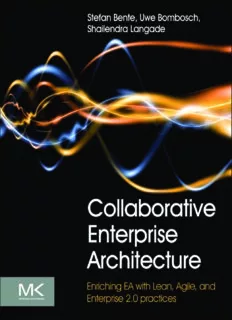
Collaborative Enterprise Architecture: Enriching EA with Lean, Agile, and Enterprise 2.0 practices PDF
Preview Collaborative Enterprise Architecture: Enriching EA with Lean, Agile, and Enterprise 2.0 practices
Collaborative Enterprise Architecture Intentionally left as blank Collaborative Enterprise Architecture Enriching EA with Lean, Agile, and Enterprise 2.0 Practices Stefan Bente Dr. Uwe Bombosch Shailendra Langade AMSTERDAM (cid:129) BOSTON (cid:129) HEIDELBERG (cid:129) LONDON NEW YORK (cid:129) OXFORD (cid:129) PARIS (cid:129) SAN DIEGO SAN FRANCISCO (cid:129) SINGAPORE (cid:129) SYDNEY (cid:129) TOKYO Morgan Kaufmann is an imprint of Elsevier AcquiringEditor:AndreaDierna DevelopmentEditor:RobynDay ProjectManager:JessicaVaughan Designer:GregHarris MorganKaufmannisanimprintofElsevier 225WymanStreet,Waltham,MA02451,USA #2012Elsevier,Inc.Allrightsreserved. Nopartofthispublicationmaybereproducedortransmittedinanyformorbyanymeans,electronic ormechanical,includingphotocopying,recording,oranyinformationstorageandretrievalsystem, withoutpermissioninwritingfromthepublisher.Detailsonhowtoseekpermission,furtherinformationaboutthe Publisher’spermissionspoliciesandourarrangementswithorganizationssuchastheCopyrightClearanceCenter andtheCopyrightLicensingAgency,canbefoundatourwebsite:www.elsevier.com/permissions. ThisbookandtheindividualcontributionscontainedinitareprotectedundercopyrightbythePublisher(other thanasmaybenotedherein). Notices Knowledgeandbestpracticeinthisfieldareconstantlychanging.Asnewresearchandexperiencebroaden ourunderstanding,changesinresearchmethodsorprofessionalpractices,maybecomenecessary.Practitioners andresearchersmustalwaysrelyontheirownexperienceandknowledgeinevaluatingandusingany informationormethodsdescribedherein.Inusingsuchinformationormethodstheyshouldbemindfulof theirownsafetyandthesafetyofothers,includingpartiesforwhomtheyhaveaprofessionalresponsibility. Tothefullestextentofthelaw,neitherthePublishernortheauthors,contributors,oreditors,assumeanyliability foranyinjuryand/ordamagetopersonsorpropertyasamatterofproductsliability,negligenceorotherwise,or fromanyuseoroperationofanymethods,products,instructions,orideascontainedinthematerialherein. LibraryofCongressCataloging-in-PublicationData Bente,Stefan. Collaborativeenterprisearchitecture:enrichingEAwithlean,agile,andenterprise2.0practices/ StefanBente,UweBombosch,ShailendraLangade. p.cm. Includesbibliographicalreferencesandindex. ISBN978-0-12-415934-1 1. Managementinformationsystems.2. Businessenterprises–Computernetworks.3. Informationtechnology– Management.4. Softwarearchitecture.I.Bombosch,Uwe.II.Langade,Shailendra.III.Title. HD30.213.B4632013 658.4’038011–dc23 2012014682 BritishLibraryCataloguing-in-PublicationData AcataloguerecordforthisbookisavailablefromtheBritishLibrary. ISBN:978-0-12-415934-1 PrintedintheUnitedStatesofAmerica 12 13 14 15 16 10 9 8 7 6 5 4 3 2 1 ForinformationonallMKpublicationsvisitourwebsiteatwww.mkp.com To our families (Beate and Thomas; Christiane and Julian; Deepali, Pratik, and Tanishka), with many thanks for their support and patience. Intentionally left as blank Contents Acknowledgments................................................................................................................................xi CHAPTER 1 Why Collaborative Enterprise Architecture?......................................................1 Reasons for This Book...............................................................................................1 GoalsandBenefits ofEnterprise Architecture..........................................................4 Controlling IT Complexity..................................................................................6 AligningBusinessand IT....................................................................................9 The Gray Reality:Enterprise Architecture Failures................................................11 Between Success and Disappointment..............................................................12 Perspective: Between Bird’s-Eye View and Nitty-Gritty on the Ground........14 Governance: AHostofDirectives, butNoOne Follows Them......................19 Strategy:Marathon or100 mRun?...................................................................21 Transformation:Between Standstilland Continuous Revolution....................23 Enriching EAby Lean, Agile, and Enterprise 2.0 Practices...................................25 How This BookIs Structured............................................................................28 CHAPTER 2 What Is Enterprise Architecture?....................................................................31 The MeaningofArchitecture...................................................................................31 Applying Architectureto anEnterprise...................................................................34 EA Applicability and Use........................................................................................36 CHAPTER 3 What Enterprise Architects Do: CoreActivities ofEA.......................................39 Definingthe IT Strategy(EA-1)..............................................................................41 Definingthe Goals.............................................................................................42 Stipulatingthe Rules.........................................................................................43 The Gartner Grid...............................................................................................46 Identifying the Initiatives..................................................................................48 The Role of anEnterprise Architect.................................................................49 Modelingthe Architectures (EA-2).........................................................................49 Models and Views ofVariousArchitectures....................................................49 Visualizing Cross-Relations andTransformations............................................51 Modeling Standards...........................................................................................52 Evolvingthe IT Landscape (EA-3)..........................................................................58 Application Rationalization...............................................................................58 GeneralIT Transformations..............................................................................66 SOA Transformations........................................................................................67 Assessingand BuildingCapabilities (EA-4)...........................................................69 Competence Development for Enterprise Architects.......................................69 vii viii Contents FormalizingEnterprise Architecture.................................................................74 EATeam Position inthe Organization Structure.............................................76 Developing and Enforcing Standards andGuidelines (EA-5)................................78 Standardizing onTechnology Usage................................................................79 Enforcing Standards and Guidelines.................................................................83 Monitoring the Project Portfolio (EA-6)..................................................................86 Building the Project Portfolio...........................................................................87 Auditing the Portfolio........................................................................................93 Leadingor Coaching Projects (EA-7)......................................................................98 Managing Risks Involvedin IT(EA-8).................................................................100 CHAPTER 4 EA Frameworks...........................................................................................105 What isan EAFramework?...................................................................................106 The Zachman Frameworkfor Enterprise Architecture..........................................108 The Open Group Architecture Framework(TOGAF)...........................................110 TOGAF ArchitectureDevelopmentMethodology (ADM)............................111 TOGAF ArchitectureContentFramework.....................................................114 TOGAF ArchitectureCapability Framework.................................................115 GartnerMethodology (Formerly META Framework)...........................................118 The Role and Use ofEA frameworks....................................................................121 CHAPTER 5 EA Maturity Models.....................................................................................123 Applying Maturity Model to EA............................................................................124 What isaMaturityModel?.............................................................................124 Relevance ofMaturityModels inEA.............................................................126 ARule ofThumb for the Architectural Maturityofan Enterprise................126 OMB EAAssessment Framework.........................................................................127 Architecture Capability Maturity Model ofthe US Department ofCommerce...130 EAMaturityModel by MIT Center for InformationSystemResearch................132 Experiences with the MaturityModels..................................................................134 CHAPTER 6 Foundations ofCollaborativeEA...................................................................137 Reflections on Complexity.....................................................................................139 Beyond Threshing Machines...........................................................................139 Structureand Behavior ofComplexPhenomena............................................140 Principles ofManaging Complexity...............................................................141 Management Capabilities of Hierarchies andNetworks................................146 The EADashboard asa Yardstick for EAEffectiveness......................................152 CHAPTER 7 TowardPragmatism: Leanand Agila EA........................................................159 The Architecture Factory: Applying Lean and Agile Methods toEA..................160 Lean and Agile Principles as Facilitatorsfor the ArchitectureFactory.........162 Contents ix Definition ofa Lean andAgile EA.................................................................163 Lean and Agile Principles......................................................................................165 Team-driven and Flexible: Agile SoftwareDevelopment..............................165 Learningfrom Mass Production: Lean SoftwareDevelopment.....................174 Lean andAgile:Parallels andDifferences.....................................................180 Building Block 1:GetRid of Waste by Streamlining Architecture Processes....182 The Seven Wastes of EA................................................................................183 Value Stream AnalysisTools for EA.............................................................193 Transition toa Lean andAgile EA Organization...........................................203 Summing It Up:Assessment by the EADashboard.......................................205 BuildingBlock2:InvolveallStakeholdersbyInterlockingArchitectureScrums..205 AnAgile EA Project.......................................................................................206 Scrum Patternsfor EA.....................................................................................209 Summing It Up:Assessment by the EADashboard.......................................215 Building Block 3:PracticeIterativeArchitecture Through EAKanban..............216 Agile EA Requirements Management............................................................217 AnEA Kanban Board Using TOGAFADM..................................................222 Synchronization with Implementation Projects..............................................230 Summing It Up:Assessment by the EADashboard.......................................233 CHAPTER 8 Inviting to Participation: EAM2.0.................................................................235 APrimer on Enterprise 2.0....................................................................................237 Building Block 4:Participation inKnowledge......................................................246 The Strategy Blog............................................................................................247 Collaborative Data Modeling:The ObjectPedia.............................................249 Weak Ties anda Self-Organizing Application Landscape............................251 Summing It Up:Assessment by the EADashboard.......................................256 Building Block 5:Participation inDecisions........................................................258 The DiagnosticProcessLandscape.................................................................259 The Bazaar ofIT Opportunities......................................................................261 Summing It Up:Assessment by the EADashboard.......................................264 Building Block 6:Participation inTransformation...............................................265 MashingUpthe ArchitectureContinuum.......................................................265 The Change Management Microblog..............................................................270 Summing It Up:Assessment by the EADashboard.......................................277 The BottomLine: Inviting toExplore...................................................................278 CHAPTER 9 TheNext Steps: Taking Collaborative EA Forward..........................................279 ASummary.............................................................................................................279 GettingStartedwith Collaborative EA..................................................................283 Interpretingthe Organizational AttitudeTowardChange..............................283
Description: